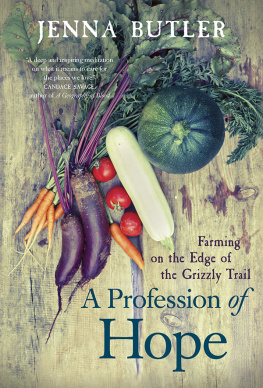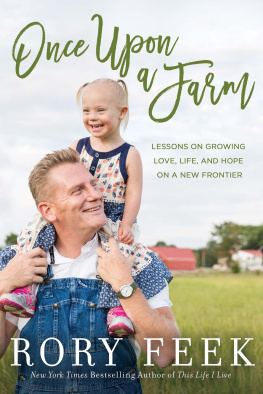No part of this publication may be reproduced, stored in a retrieval system or transmitted, in any form or by any means, without the prior written consent of the publisher or a license from the Canadian Copyright Licensing Agency (Access Copyright). For an Access Copyright license, visit www.accesscopyright.ca or call toll free to 1-800-893-5777.
The publisher gratefully acknowledges the support of the Canada Council for the Arts, the Ontario Arts Council and the Canada Book Fund.
Wolsak and Wynn Publishers Ltd.
280 James Street North
Hamilton, ON
Canada L8R 2L3
Cataloguing data available from Library and Archives Canada.
ISBN 978-1-928088-20-2 (ebook)
Farming is a profession of hope.
PREAMBLE
IN AN ERA OF LARGE-SCALE agribusiness and multinational corporations dedicated to the privatization and control of the worlds seed stocks for profit, starting out as a small-scale farmer seems like an uphill slog, a thankless task. But theres beauty in it, found in the steadily growing community of supporters who are searching for more than just local food. Theyre looking for a way back to the land itself, its histories and pleasures, in a form far different than the gigantic feedlots, pumpjacks and canola fields that checker the North American prairies. They want a hands-on experience when it comes to food and to the land that produces it. Instead of needing a haz-mat suit to grub chemically drenched Yukon Golds out of the field, they want to be able to scrabble out their produce with bare hands. Even better, with the kids in tow.
In spite of the burgeoning support base for small farms in North America, theres still the wider issue of food security in a country such as Canada, where most of the people (and thus, the small farms) are located in a relatively limited southern belt. With overseas food shortages and domestic food prices on an ever more drastic rise as an environment under threat becomes increasingly unpredictable, theres an immediate concern regarding food production in Canadas colder climates.
This is where the northern small farms come in, in all their quirky glory. Theyre places capable of producing a great deal of high-quality food in a manner that doesnt take more from the land than the soil can bear. Small-scale organic farming methods offer ways of reclaiming marginal land whose goodness has been used up, putting into play farming methods that allow for a strengthening, rather than a wholesale destruction, of ecosystems. These are the spaces that protect and preserve the heirloom seeds passed down for generations and adapted specifically to the strictures of our local weather. At the same time, theyre more than just cold-zone seed vaults: Canadian small farms are places in which the rough beauty of the landscape can be seen thrumming just beneath the surface of daily life. For the many who live on them, they represent a tying together of ideology, economics and functionality. These farms provide fiscally viable returns to the natural world in a diversified way that is no longer possible on many large-scale operations. Small farms are celebrations of what it means to live closely and responsibly with the land through all seasons, no matter what the weather or the economy throws your way.
Right now, the weather is throwing an eight-month winter our way. We found our farm during a winter much like this one back in 2006: the land was wild, overgrown and sunk in snowdrifts to the knees. We were captivated. We spent the dark months of 2006 snowshoeing the land before we signed to it, but we knew what wed find come the melt in April. The quarter section (one hundred sixty acres here in Canada, rather cryptically listed on the deed as 160 acres, more or less) consists of one hundred thirty-five acres of northern mixed forest and boreal muskeg spruce (dwarf black spruce growing over deep peat bogs thick with Labrador tea). At the far corner stands a twenty-five-acre hayfield that one of the neighbours keeps in alfalfa for his dairy cows. When we found the land, we had no illusions. We knew that the only reason the quarter was going for a price that two teachers, living in a tiny rented apartment in the city, could afford was that it was rough northern bush. All of the big industrial farmers in the neighbourhood had looked at that land and turned it down. Too much effort, they later told us. Too much work to clear, and too much peat.
But where they saw wasted effort and backhoes sinking into acidic bog water, as would-be small farmers, we saw something else. The land had scarcely been touched, and while the access was poor and the ground springy with peat, the forest offered a built-in buffer zone from the conventional farms around us. The hayfield was beyond our reach at that point; at the far end of a rough old seismic line that turned into a swampy track in the spring, it was an ideal building site with dirt-poor access. We rented it out another year to the neighbour, who was happy to have the extra twenty-five acres after a bad year for hay the summer before. Every extra bale he could bring in was one fewer hed have to buy. We turned his first rent cheque over to equipment and began nibbling away at the corner of the property that fronts onto the township road. A dead willow thicket, it promised easiest access for clearing. For gardening, it boasted earth that was deep and rich from years upon years of untouched willow-leaf mulch and decaying swamp grass.
A bucolic farm life? Nothing was farther from the truth that first year. The land was an hour and a half from Edmonton, and without a place to stay, we were driving out and back every Saturday and Sunday, pacing clearing work against full-time teaching jobs. The same dark, moist earth that promised a spectacular garden in future years yielded us an unwelcome bumper crop that first spring: a hatch of mosquitoes so bad that they literally coated us from head to foot the moment we emerged from the car. This was followed by a batch of nettles that reached five feet in the unrestricted root run of peaty soil.
This is not the story of a ready-made farm, complete with generations of history, carefully tended tools and sturdy clapboard farmhouse. Those came later, as we learned the stories of our county and added a cabin of our own to the land. That first summer, though, there was nothing to move into, and so we moved out . After our teaching jobs wrapped up for the summer, we spent every available moment out on the land. At its most basic, it was literally just us, an axe, a chainsaw and a quarter section of northern bush picked out in inquisitive moose.










